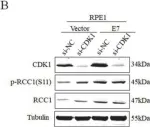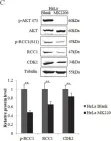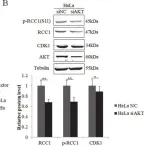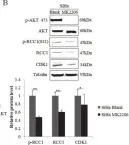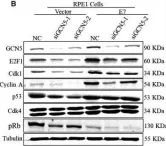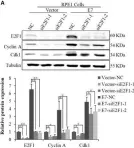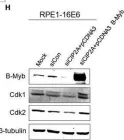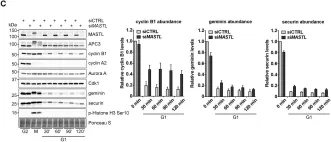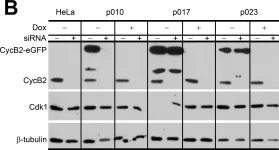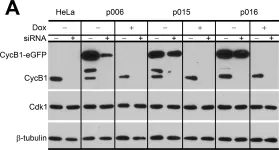During mitosis, chromosome alignment at the mitotic spindle equator grants correct chromosome segregation and proper nuclei formation in daughter cells. The kinesin 8 family member Kif18A plays a crucial role for chromosome alignment by localizing at the kinetochore-microtubule (K-MT) plus ends to dampen MT dynamics and stabilize K-MT attachments. Kif18A action is directly antagonized by the master mitotic kinase cyclin B-dependent kinase 1 (Cdk1) and is promoted by protein phosphatase 1 (PP1). Since chromosome alignment precedes Cdk1 inactivation by cyclin B proteolysis, it is unclear how Kif18A evades Cdk1 inhibition.
We analyzed chromosome alignment and Kif18A in mitotic cells upon genetic perturbation of the phosphorylation-dependent inhibitory control of Cdk1 activity by immunofluorescence and cell fractionation experiments.
We show here that chromosome alignment in human cells relies on a recently identified fraction of Cdk1 that is inhibited by Wee1-dependent phosphorylation in mitosis (i-Cdk1, standing for inhibited/inactive-Cdk1) and that localized at spindle structures where it promotes proper spindle assembly. Indeed, the reduction of i-Cdk1 led to several spindle defects including spindles with misaligned, bipolarly attached chromosomes showing poor Kif18A localization at their K-MT plus ends. Restoring i-Cdk1 reversed both alignment defects and Kif18A localization. In cells with lowered i-Cdk1, expressing a phosphonull Kif18A mutant version at the sites that serve as Cdk1 substrate significantly rescued the alignment defects.
Mechanistically, our evidence suggests that i-Cdk1 and active PP1 facilitated the dephosphorylation and reactivation of spindle-localized Kif18A. Considering the relevance of Kif18A for survival of aneuploid cancer cells and the potential therapeutic targeting of both Kif18A and Wee1, these findings could also be relevant for cancer therapy.
Copyright © 2024 Serpico, Pisauro, Trano and Grieco.
Product Citations: 33
Chromosome alignment and Kif18A action rely on spindle-localized control of Cdk1 activity.
In Frontiers in Cell and Developmental Biology on 29 November 2024 by Serpico, A. F., Pisauro, C., et al.
-
WB
-
Homo sapiens (Human)
-
Genetics
Chromosome alignment relies on spindle-localized control of Cdk1 activity
Preprint on Research Square on 3 July 2024 by Serpico, A. F., Pisauro, C., et al.
Abstract During mitosis, chromosome alignment at the mitotic spindle equator grants correct chromosome segregation and proper nuclei formation in daughter cells. A central role for chromosome alignment is exerted by the kinesin 8 family member Kif18A that localizes at the kinetochore-microtubule (K-MT) plus ends where it dampens MT dynamics stabilizing K-MT attachments. Kif18A action is directly antagonized by the master mitotic kinase cyclin B-dependent kinase 1 (Cdk1) and promoted by protein phosphatase 1 (PP1). Since chromosome alignment precedes Cdk1 inactivation by cyclin B proteolysis it is unclear how Kif18A evicts Cdk1 inhibition. We show here that chromosome alignment in human cells relies on a recently identified fraction of Cdk1 that is inhibited by phosphorylation in mitosis (i-Cdk1, for inhibited/inactive-Cdk1), localized at spindle structures and required for proper spindle assembly. Indeed, lowering i-Cdk1 induced several spindle defects including spindles with misaligned, bipolarly attached, chromosomes that showed poor Kif18A localization at K-MT plus ends. Both alignment defects and Kif18A localization were reversed by restoring i-Cdk1. In i-Cdk1-lowered cells, alignment defects were also significantly rescued by expressing a phosphorylation-resistant Kif18A version at Cdk1-dependent sites. Mechanistically, our evidence indicates that i-Cdk1 and active PP1 promoted spindle-localized Kif18A dephosphorylation. Given the relevance of Kif18A for survival of aneuploid cancer cells, these observations may also have relevance for cancer therapy.
-
Homo sapiens (Human)
-
Genetics
Genomic and immune landscape Of metastatic pheochromocytoma and paraganglioma.
In Nature Communications on 28 February 2023 by Calsina, B., Piñeiro-Yáñez, E., et al.
The mechanisms triggering metastasis in pheochromocytoma/paraganglioma are unknown, hindering therapeutic options for patients with metastatic tumors (mPPGL). Herein we show by genomic profiling of a large cohort of mPPGLs that high mutational load, microsatellite instability and somatic copy-number alteration burden are associated with ATRX/TERT alterations and are suitable prognostic markers. Transcriptomic analysis defines the signaling networks involved in the acquisition of metastatic competence and establishes a gene signature related to mPPGLs, highlighting CDK1 as an additional mPPGL marker. Immunogenomics accompanied by immunohistochemistry identifies a heterogeneous ecosystem at the tumor microenvironment level, linked to the genomic subtype and tumor behavior. Specifically, we define a general immunosuppressive microenvironment in mPPGLs, the exception being PD-L1 expressing MAML3-related tumors. Our study reveals canonical markers for risk of metastasis, and suggests the usefulness of including immune parameters in clinical management for PPGL prognostication and identification of patients who might benefit from immunotherapy.
© 2023. The Author(s).
-
IHC
-
Homo sapiens (Human)
-
Cancer Research
-
Immunology and Microbiology
In Cell Death & Disease on 6 December 2022 by Toh, E., Baryalai, P., et al.
Recently, we demonstrated that a novel bacterial cytotoxin, the protein MakA which is released by Vibrio cholerae, is a virulence factor, causing killing of Caenorhabditis elegans when the worms are grazing on the bacteria. Studies with mammalian cell cultures in vitro indicated that MakA could affect eukaryotic cell signalling pathways involved in lipid biosynthesis. MakA treatment of colon cancer cells in vitro caused inhibition of growth and loss of cell viability. These findings prompted us to investigate possible signalling pathways that could be targets of the MakA-mediated inhibition of tumour cell proliferation. Initial in vivo studies with MakA producing V. cholerae and C. elegans suggested that the MakA protein might target the PIP5K1α phospholipid-signalling pathway in the worms. Intriguingly, MakA was then found to inhibit the PIP5K1α lipid-signalling pathway in cancer cells, resulting in a decrease in PIP5K1α and pAkt expression. Further analyses revealed that MakA inhibited cyclin-dependent kinase 1 (CDK1) and induced p27 expression, resulting in G2/M cell cycle arrest. Moreover, MakA induced downregulation of Ki67 and cyclin D1, which led to inhibition of cell proliferation. This is the first report about a bacterial protein that may target signalling involving the cancer cell lipid modulator PIP5K1α in colon cancer cells, implying an anti-cancer effect.
© 2022. The Author(s).
-
WB
-
Cancer Research
-
Cell Biology
In Nucleic Acids Research on 24 June 2022 by McIntyre, A. J., Angel, C. Z., et al.
Chromosome 17q23 amplification occurs in 20% of primary breast tumours and is associated with poor outcome. The TBX2 gene is located on 17q23 and is often over-expressed in this breast tumour subset. TBX2 is an anti-senescence gene, promoting cell growth and survival through repression of Tumour Suppressor Genes (TSGs), such as NDRG1 and CST6. Previously we found that TBX2 cooperates with the PRC2 complex to repress several TSGs, and that PRC2 inhibition restored NDRG1 expression to impede cellular proliferation. Here, we now identify CoREST proteins, LSD1 and ZNF217, as novel interactors of TBX2. Genetic or pharmacological targeting of CoREST emulated TBX2 loss, inducing NDRG1 expression and abolishing breast cancer growth in vitro and in vivo. Furthermore, we uncover that TBX2/CoREST targeting of NDRG1 is achieved by recruitment of TBX2 to the NDRG1 promoter by Sp1, the abolishment of which resulted in NDRG1 upregulation and diminished cancer cell proliferation. Through ChIP-seq we reveal that 30% of TBX2-bound promoters are shared with ZNF217 and identify novel targets repressed by TBX2/CoREST; of these targets a lncRNA, LINC00111, behaves as a negative regulator of cell proliferation. Overall, these data indicate that inhibition of CoREST proteins represents a promising therapeutic intervention for TBX2-addicted breast tumours.
© The Author(s) 2022. Published by Oxford University Press on behalf of Nucleic Acids Research.
-
WB
-
Biochemistry and Molecular biology
-
Cancer Research
In Cell Death Dis on 6 December 2022 by Toh, E., Baryalai, P., et al.
Fig.4.A

-
WB
-
Collected and cropped from Cell Death Dis by CiteAb, provided under a CC-BY license
Image 1 of 19
In Biomolecules on 6 July 2021 by Hou, X., Qiao, L., et al.
Fig.1.B

-
WB
-
Collected and cropped from Biomolecules by CiteAb, provided under a CC-BY license
Image 1 of 19
In Biomolecules on 6 July 2021 by Hou, X., Qiao, L., et al.
Fig.1.C

-
WB
-
Collected and cropped from Biomolecules by CiteAb, provided under a CC-BY license
Image 1 of 19
In Biomolecules on 6 July 2021 by Hou, X., Qiao, L., et al.
Fig.5.C

-
WB
-
Collected and cropped from Biomolecules by CiteAb, provided under a CC-BY license
Image 1 of 19
In Biomolecules on 6 July 2021 by Hou, X., Qiao, L., et al.
Fig.5.B

-
WB
-
Collected and cropped from Biomolecules by CiteAb, provided under a CC-BY license
Image 1 of 19
In Biomolecules on 6 July 2021 by Hou, X., Qiao, L., et al.
Fig.6.C

-
WB
-
Collected and cropped from Biomolecules by CiteAb, provided under a CC-BY license
Image 1 of 19
In Biomolecules on 6 July 2021 by Hou, X., Qiao, L., et al.
Fig.6.B

-
WB
-
Collected and cropped from Biomolecules by CiteAb, provided under a CC-BY license
Image 1 of 19
In J Cell Mol Med on 1 November 2018 by Qiao, L., Zhang, Q., et al.
Fig.3.B

-
WB
-
Collected and cropped from J Cell Mol Med by CiteAb, provided under a CC-BY license
Image 1 of 19
In J Cell Mol Med on 1 November 2018 by Qiao, L., Zhang, Q., et al.
Fig.3.A

-
WB
-
Collected and cropped from J Cell Mol Med by CiteAb, provided under a CC-BY license
Image 1 of 19
In J Cell Mol Med on 1 November 2018 by Qiao, L., Zhang, Q., et al.
Fig.4.A

-
WB
-
Collected and cropped from J Cell Mol Med by CiteAb, provided under a CC-BY license
Image 1 of 19
In J Cell Mol Med on 1 September 2018 by Tian, Y., Chen, H., et al.
Fig.6.B

-
WB
-
Collected and cropped from J Cell Mol Med by CiteAb, provided under a CC-BY license
Image 1 of 19
In J Cell Mol Med on 1 September 2018 by Tian, Y., Chen, H., et al.
Fig.5.H

-
WB
-
Collected and cropped from J Cell Mol Med by CiteAb, provided under a CC-BY license
Image 1 of 19
In J Cell Mol Med on 1 September 2018 by Tian, Y., Chen, H., et al.
Fig.4.A

-
WB
-
Collected and cropped from J Cell Mol Med by CiteAb, provided under a CC-BY license
Image 1 of 19
In Oncotarget on 10 March 2015 by Zhang, W., Chen, H., et al.
Fig.6.A

-
WB
-
Collected and cropped from Oncotarget by CiteAb, provided under a CC-BY license
Image 1 of 19
In Oncotarget on 10 March 2015 by Zhang, W., Chen, H., et al.
Fig.4.B

-
WB
-
Collected and cropped from Oncotarget by CiteAb, provided under a CC-BY license
Image 1 of 19
In Biol Open on 6 March 2015 by Voets, E. & Wolthuis, R.
Fig.2.C

-
WB
-
Homo sapiens (Human)
Collected and cropped from Biol Open by CiteAb, provided under a CC-BY license
Image 1 of 19
In PLoS One on 11 December 2013 by Huang, Y., Sramkoski, R. M., et al.
Fig.8.A

-
WB
-
Collected and cropped from PLoS One by CiteAb, provided under a CC-BY license
Image 1 of 19
In PLoS One on 11 December 2013 by Huang, Y., Sramkoski, R. M., et al.
Fig.3.B

-
WB
-
Collected and cropped from PLoS One by CiteAb, provided under a CC-BY license
Image 1 of 19
In PLoS One on 11 December 2013 by Huang, Y., Sramkoski, R. M., et al.
Fig.3.A

-
WB
-
Homo sapiens (Human)
Collected and cropped from PLoS One by CiteAb, provided under a CC-BY license
Image 1 of 19

